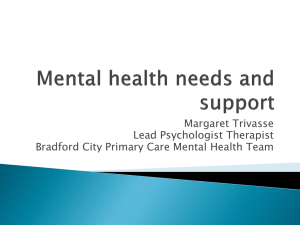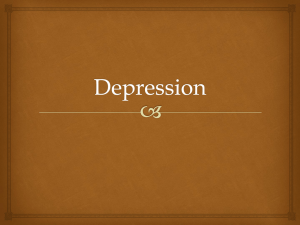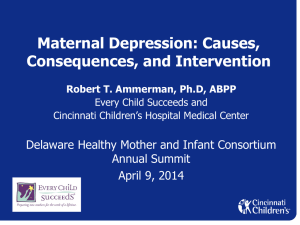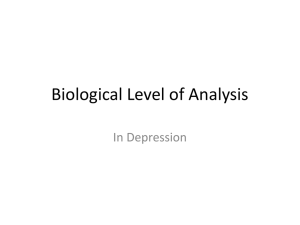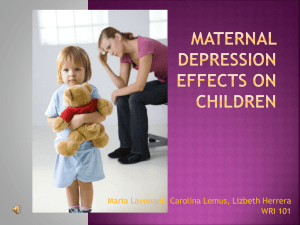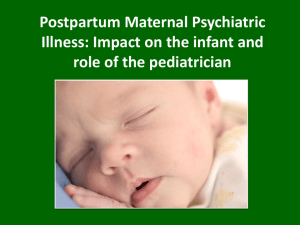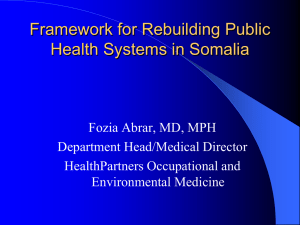Postpartum Depression: - IASA
advertisement
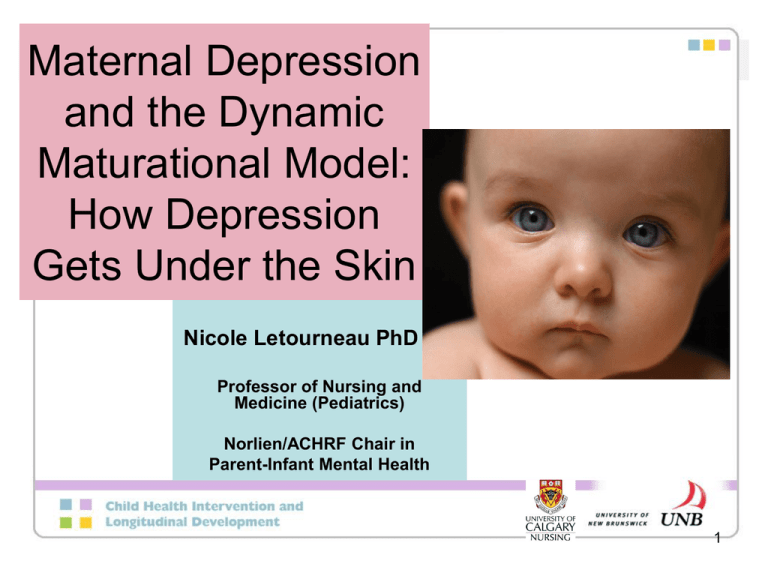
Maternal Depression and the Dynamic Maturational Model: How Depression Gets Under the Skin Nicole Letourneau PhD RN Professor of Nursing and Medicine (Pediatrics) Norlien/ACHRF Chair in Parent-Infant Mental Health 1 Objectives 1. Maternal depression and attachment 2. Maternal depression and mother-infant interaction 3. Impact of depression on infant and child health 4. How does maternal depression get under the skin? 5. So what do we do? 2 1. MATERNAL DEPRESSION & ATTACHMENT 3 MDD symptoms Weight Loss/Gain Depressed Mood Fatigue/ Loss of Energy Insomnia/ Hypersomnia Anxiety Emotional Lability Reduced Thinking/ Concentration/ Decisiveness Worthlessness/ Guilt Psychomotor Agitation or Retardation Loneliness Loss of Interest or Pleasure Suicidal Ideation 4 Mothers • DSM-IV indicates that mothers must experience s/s within 4 weeks postpartum to have MDD with postpartum onset • Beyond 1st year, symptoms of depression are not attributed to the postpartum period. • Meta-analysis of 28 studies reported PPD prevalence of 15% (Gavin et al., 2005), slightly ↑ over last review (O’hara & Swain, 1996) • Maternal depression 5-7% (Health Canada & NLSCY) 5 Mothers • 50% of mothers with PPD remain clinically depressed at 6 months postpartum. • 25% untreated mothers remain depressed > 1 year. • 63% have recurrence of depression within 12 years. Letourneau et al. (2010) WJNR 6 Does it all begin during pregnancy? • MDD during pregnancy related to poor maternal-fetal attachment (McFarlane, 2011) • Maternal mood related to maternal cortisol levels during pregnancy (Giesbrecht et al., 2011) • High maternal cortisol during pregnancy predicted parental report of poor infant temperament 7 8 Matenal depression=serious • 12% of maternal deaths (during pregnancy and in the 1st year post delivery) attributed to psychiatric illness including PPD • #1 cause of death: suicide (10%) • More violent methods of suicide-few by overdose (Oates, 2003. Confidential Enquiries into Maternal Deaths) 9 10 Disturbing thoughts [1] Location Total screened EPDS 9+ Positive for self harm EPDS 12+[1] Positive for self harm Fredericton 109 24 (22%) 7 (29%) 12 (11%) 5 (42%) Moncton 299 55 (18%) 19 (35%) 34 (12%) 14 (42%) This group is also counted in the EPDS 9+ category. Duffett-Leger, L.. & Letourneau, N. (2009). Info Nursing Parental distress increased the odds (OR: 1.10; CI: .99-1.21) of having thoughts of intentional harm to child at 4 weeks postpartum (e.g. screaming at baby, shaking baby, hitting baby, giving away baby, etc.) (Fairbrother & Woody, 2008) 11 Suicidality and attachment • Mothers with high suicidality (n=32) – experienced greater mood disturbances, cognitive distortions, and depression severity of postpartum symptomotology – lower maternal self-esteem, more negative perceptions of the mother-infant relationship, and greater parenting stress. • During observations, mothers were less sensitive and responsive to infants' cues, and infants demonstrated less positive affect and involvement with their mothers. Paris et al., 2009 12 13 Disturbing thoughts Barr and Beck (2008) conclude: “although women were unlikely to disclose their infanticide thoughts to health care professionals, they did often realize that they needed help. In such cases, women were more likely to mention thoughts of suicide…” 14 There is no such thing as a baby— Winnicott 15 What is Attachment? •The pattern of a specific relationship •A self-protective strategy Pattern reflects whether children feel secure in the availability and responsiveness of caregivers Bowlby, 1988; Ainsworth, 1978; Crittenden, 2005 16 Why these strategies? • Type A minimize awareness of feelings and do what will be reinforced and to avoid doing what will be punished— disorders of inhibition and compulsion. E.g a child responded to negatively each time she cries may develop a Type A strategy. • Type C focus on feelings as guides to behaviour— disorders of anxiety and obsessiveness tied to too great a reliance on negative affect. E.g. a child who is ignored by a passive parent unless acts out may develop Type C strategy 18 19 20 21 22 Attachment & development Over the lifespan, insecure attachment is associated with: • Behavioural, academic and mental health problems • Problems with intimacy and affection • Trust issues • Low self-esteem • Difficulty maintaining relationships 23 Insecure attachment Primary caregiver : Insensitive Disengaged Uninvolved Emotionally flat Controlling Infants develop: Self-protective strategies PPD & attachment: infancy Non-depressed Type C 10% Depressed Type A 10% Type D 10% Type A 17% Type C 23% Type B 20% Type B 70% Type D 40% Teti, Gelfand, Messinger, & Isabella (1995) 25 PPD & attachment: preschoolers Non-Depressed Depressed Type ADType A A/ C-IO 9% Type C 29% 26% Type C Type A 19% Type B 13% 22% Type ADA/C-IO 29% Type B 43% Teti, et al. (1995). 26 Forman et al. (2007) • Depressed moms • Children of depressed less responsive, mothers, compared to viewed their infants children in nonmore negatively depressed control • 18 mos. later, group, were depressed moms significantly lower in rated their kids lower attachment security in attachment, behaviour & temperament 27 2. POSTPARTUM DEPRESSION AND MATERNAL-INFANT INTERACTION 28 29 30 States of arousal • • • • • • Flooded (e.g. crying) Hyper-alert (e.g. fussy) Calmly focused & alert Hypo-alert Drowsy Asleep 31 Maternal-child interaction & self-regulation Critical aspect of regulating a baby’s states involves modulating the intensity of stimulus to engage and sustain the baby’s attention i.e not trigger the impulse to cry, avert gaze, or shut down. 32 Adult sensitivity is any pattern of behavior that pleases the infant and increases the infant’s comfort and attentiveness and reduces its distress and/or disengagement. (Crittenden, 2011) 33 Mothers are “hidden” regulators of their infants’ endocrine & nervous systems 34 What interferes with maternal sensitivity? Attachment & trauma history Mental health problems Family violence Maternal addictions Current or Past stress 35 PPD & maternal-infant interaction When I tried to encourage some social interaction with her newborn, Stephanie would respond that she often just stared at Emma. While other relatives laughed and cooed to the baby, Stephanie claimed that she did not know how and had no desire to do that. Some of her responses were “ I don’t know what to say”, “Is it bad that I just stare at her?” and “Am I being a bad mother?” From Zauderer (2008) 36 Depressed mothers • negative perceptions • ↓ sensitive and of normal infant appropriate behavior interactions • ↓ likely to pick up on • ↑ negative in their infants’ cues or play respond to needs • speak more slowly • ↓ emotionally and ↓ often expressive • ↓ affectionate and ↑ anxious 37 Relationships with infants • PPD ↓ maternal-child interaction quality and enjoyment in maternal role-moderate to large effect (Beck, 1995; Murray et al. 2003) • Disturbances in mother-child interactions are observed at one year postpartum, even when mothers are no longer depressed. 38 Secure attachment Sensitivity and parental availability are key determinants of secure attachment (Cassidy & Shaver, 1999; Trapolini et al., 2007) 39 4. IMPACT OF MATERNAL DEPRESSION ON INFANT AND CHILD HEALTH 40 Infant development • Meta-analysis and systematic review both suggest that PPD has a significant effect on infants’ cognitive and social development (Beck, 1998; Grace, Evindar & Stewart, 2003) • More behaviour problems – Depression, withdrawal, hyperactivity, aggression • Lower cognitive functioning – Verbal, perceptual, quantitative skills (Beck ,1998) 41 Infant behaviour <12 month old infants: • more tense, less content • fewer positive facial expressions • more negative expressions and protest behavior • drowsy, withdrawn, avoidant • more crying--fussy and disruptive • reduced sociability to strangers and performance on learning tasks • disengaged in maternalinfant interactions and in toy play • more sleep problems (Whiffen & Gotlib, 1993 Field, 1984; Murray et al., 1996; Grace et al., 2003) 42 Infant behaviour 12 to 36 month olds: • show less sharing, concentration, and sociability to strangers • show decreased positive affect • lower overall rate of interaction • less responsive and interactive (Lyons-Ruth et al., 1986; Murray, 1992; Righetti-Veltema et al., 2003) 43 Child behaviour 3 to 5 year old children: • are more “difficult” • respond in negative manner to friendly approaches by other children • boys most likely to show behaviour problems 12 year olds: • behavioral and adjustment problems and substance abuse (esp. boys) (Leinonen 2003) (Murray et al., 1999; Sinclair et al., 1996) 44 2.25 Depressed: Aggression Depressed: Anxiety Depressed: Hyperactivity Non-Depressed: Aggression 2 Non-Depressed: Anxiety Behavioral Score Non-Depressed: Hyperactivity 1.75 1.5 1.25 1 2 4 6 Age (Years) 8 45 However parenting more powerful predictor than whether or not mother was depressed 46 Offspring of postnatally depressed mothers at increased risk for depression by age 16 years, partially explained by insecure infant attachment. 4. HOW DOES MATERNAL DEPRESSION GET UNDER THE SKIN? 48 49 50 Hypothalamic-Pituitary Adrenal (HPA) Axis Cortisol is secreted by the adrenal cortex via pulsations that follow a 24hour (diurnal) circadian profile (Hellhammer, 2009) Stressors (like PPD) stimulate the activation of the HPA which triggers the release of the steroid hormone cortisol from the adrenal gland (Essex, 2002) Glucocorticoids/ cortisol HPA Axis Sensitive periods of enhanced brain plasticity vulnerable to long-term effects of cortisol Over-activation of the HPA system related to: decreases in brain volume inhibition of neurogenesis disruption of neuronal plasticity abnormal synaptic connectivity (Gunnar, 2009) HPA Axis Prolonged exposure to elevated levels of cortisol predict: increased insulin resistance obesity diminished immune responses reduced cognition, memory fear behaviours, hypervigilance attention deficits, behavioural problems disturbances with emotional regulation & self control (Essex, 2002, Gunnar, 1998) Depression & child cortisol • Infants, 3 year olds, 6-8 year olds, (r=.22, p<.005; Lupien et al., 2000) and13 year olds of depressed mothers display higher cortisol levels than children of non-depressed mothers. • Months of exposure to PPD in child’s first year of life is potent predictor of ↑cort levels. 55 Maternal Child Interaction Quality? Diurnal Rhythm Predicted Reduction in the Daily Decrease of AUC 199 Cortisol Area Under Curve 198 197 196 195 Reduction in the decrease of cortisol due to socioemotional growth below average 194 193 b=.07, p=.01 192 191 Morning Noon Afternoon Evening 58 Predicted Cortisol For Different Cognitive Growth Fostering Interaction Levels 250 b=.06, p=.04 Area Under the Curve 200 150 100 50 0 One Standard Deviation Above Average Average One Standard Deviation Below Average Summary: Infant Cortisol • Infants show an afternoon flattened pattern. • ↑ cognitive growth fostering activities predict ↓ concentrations of infant cort over the day • ↓ average social-emotional growth fostering activities predict ↓ of a decline in cort over the day (flatter decline). Symptoms or strategies? • • • • • • • Attentional problems Hypervigilance Compulsions Agitation Aggressiveness Provocativeness Acting the victim (Crittenden, A&P) 61 5. SO WHAT DO WE DO? 62 63 Reviews of Tx interventions • 2 reviews of non-biological tx conclude that: “any psychosocial or psychological intervention, compared with usual postpartum care, was associated with reduced likelihood of continued depression within the first year postpartum”. (Dennis, 2004; Dennis et al., 2007) • 2 reviews of biological tx have contrasting findings--Inconclusive (Dennis, 2004) and SSRI’s effective (Arroll et al. 2009). 64 65 The treatments (focused on S/S) had no significant impact on maternal management of early infant behaviour problems, security of infant-mother attachment, infant cognitive development or any child outcome 66 at 5 years. 67 Professional MCI for PPD • Group support for mothers with PPD provided by professionals • Same intervention as in MOMS trial provided in group setting; no focus on symptoms of PPD • Mother-infant interaction improved, PPD did not change • No control group; n=17 Jung, Short, Letourneau (2006). JAD 68 69 Professional MCI for PPD • Professional phone (focused on s/s) v. homebased maternal-child interaction guidance for mothers with PPD (n=71) • Video feedback by trained professionals • Home-based professional support provided greater impact on MCI and attachment • Depression reduced in both groups, but no difference b/w groups vanDoesum et al. (2008). Child Development. 70 Health care implications Screen all mothers with EPDS • Direct, but sensitive questions to explore whether mothers have thoughts of infanticide, esp. when suicide is mentioned (Barr & Beck, 2008) 71 Health care implications • Psychotherapeutic or psychological support for mother (Dennis Reviews) • Parent-infant interaction/relationship guidance (Jung et al., 2007; Van Doesum et al., 2008) • AAI and CARE-Index as assessment tools to guide relationship-focused intervention 72 Thank you nicole.letourneau@ualberta.ca 73
